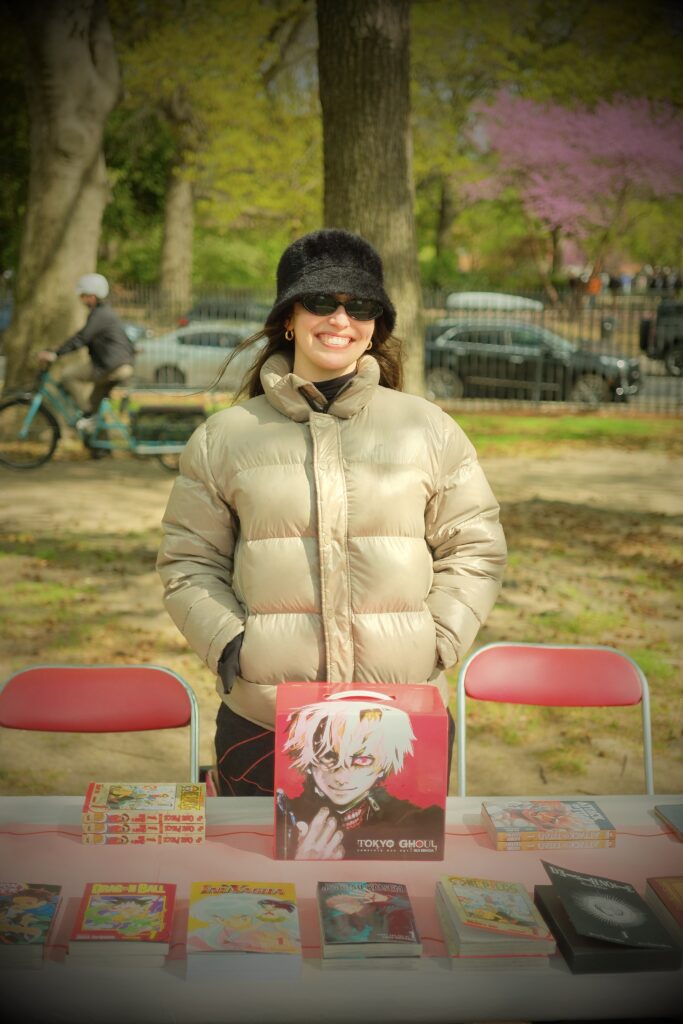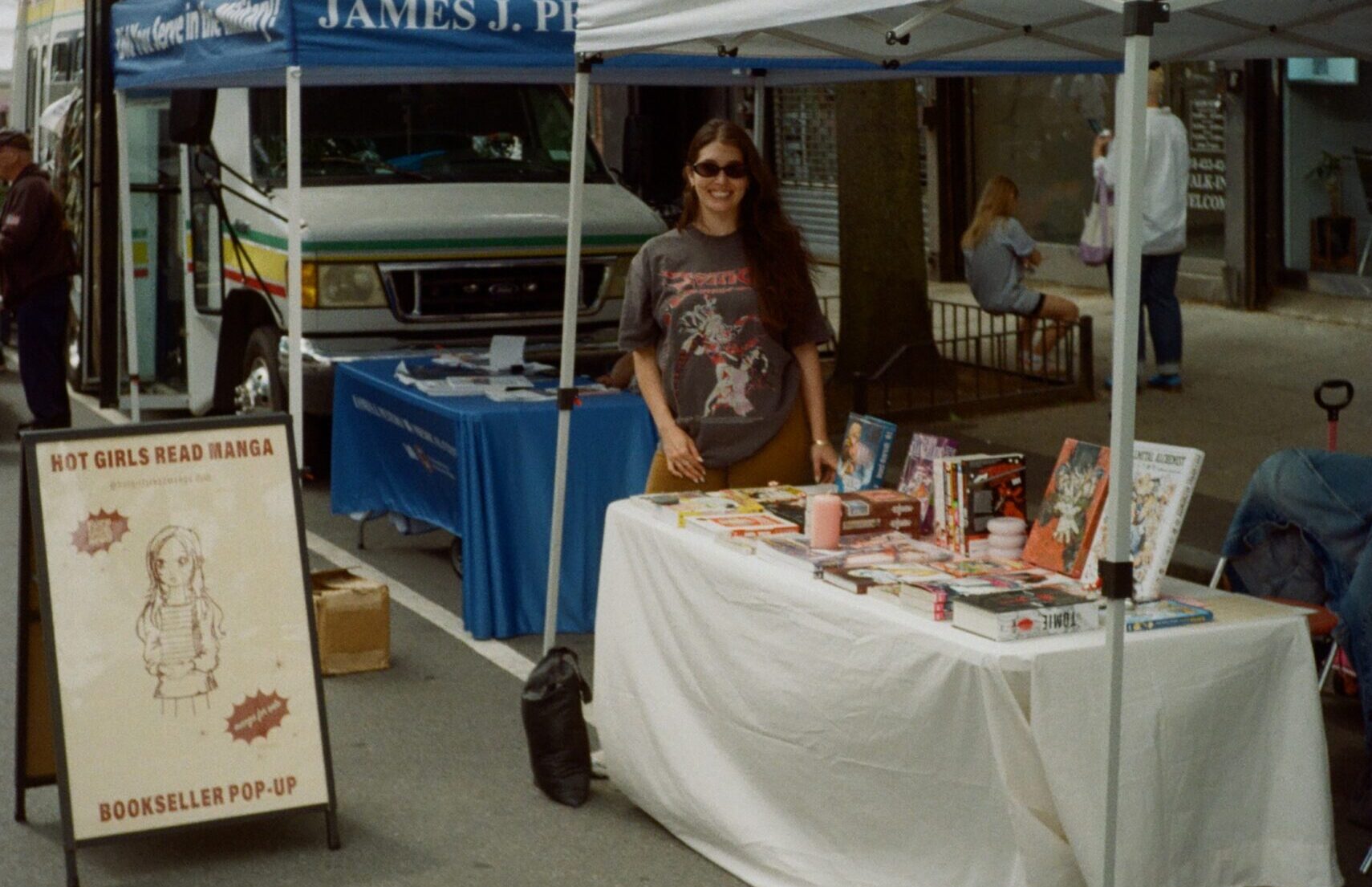With her loud and profound love for anime and all things Japanese media, Megan Thee Stallion opened very necessary doors for Black women to feel more comfortable in their quirks. Interests that were once cast aside as “nerdy” and thus shameful and isolating are now being publicly celebrated and embraced, as communities of women with overlap in hobbies build ecosystems of support for one another. Though they may feel few and far between, there are countless Black and brown women who favor Japanese media above all else. In fact, they make up a large percentage of anime and manga consumers entirely.
With that, product designer Brittney Johnson left behind the decade she invested into corporate America to launch Hot Girls Read Manga, a digital space to support her pop up book store Casita Manga, where those who proudly indulge in Japanese comic books can connect and convene.
Growing up alongside Kimi, her great-grandfather’s Japanese wife, opened up access to an entire culture that became a vital part of Johnson’s identity. Coming back home to her love of manga and anime, Hot Girls Read Manga is a passion project that highlights a vital truth about women of color who live against the status quo: they need a safe space. As a Cuban-American woman, Johnson was tasked with building the community she lacked brick by brick. 21Ninety got a chance to talk to the young entrepreneur and learn more about her the deep roots of her passion.
Hot Girls Read Manga
21Ninety spoke to the young entrepreneur to learn more about her the deep roots of her passion.
21N: Walk us through the inception of Hot Girls Read Manga.
BRITTNEY JOHNSON: Throughout my childhood, I played all these Pokemon games, watched all these shows, read all these books. This media has always been a big part of my life, even when I tried to push it away to fit the status quo. Once I reconnected with that, I felt that indescribable sense of joy you feel when you are connecting with something that you know is your true passion. My job has always been pushing pixels and ensuring that the user experience is performing well. The e-commerce corporate world is always pretending that we are doing rocket science and that people are dying. I didn’t know what it was like to feel fulfilled by your job and I knew that was never gonna change if I stayed in corporate America, whereas all of the times when I was connecting with people who also share these interests, I lit up.
I love going on tangents about all of the different series I love. I love giving recommendations, all of the cross overlap between gaming, movies, film. I just nerd out big time on that stuff. It became really clear to me that as an actual consumer of these books, the experience of going to shop for manga as an adult femme person can be unpleasant. The manga and anime community has historically been oversaturated by men, but there have always been women who are really interested in this world. They’ve resorted to online shopping, because when you go in person, there are weird smells in the shelves or a man is coming up to you to talk to you when you’re just there to buy books. I felt strongly that there should be a space for us. Kids are no longer getting bullied for being into this beautiful form of media and I think that that’s so awesome. It’s clear how much things are changing and growing. I just felt like, “Why has no one sat down and thought to create a gorgeous bookshop for the girlies, the gays, everyone?”
21N: It’s funny because Japanese media in Latino culture has seemingly always been pretty popular, even though it’s widely unacknowledged.
BJ: I mean, Dragon Ball Z is like a religion in Latin America. As I grew older, I learned that even our parents’ generation in Latino America, in Central America especially, have had these Japanese anime series that would come on their TV and paved the way for massive shows like Naruto. It’s just amazing to me when I meet other Latinos and they say like, “This was such a big part of my childhood.” Even my fiancé, he grew up in Venezuela the first seven years of his life and remembers watching Dragon Ball Zeta. It’s just so cool how it blends across cultures and really resonates.

21N: Why is it specifically important for Black and brown people to have a space like Casita Manga?
BJ: What’s really paved the way for my concept and why I know it’s going to be so successful is me looking to these incredible Black and brown creators who only further validate that this community wants and deserves more spaces to connect. Most of my favorite creators who I follow and really admire are people of color. There’s this amazing African American manga artist named KofiManga who left the US to study in Japan. He is fluent in Japanese and is now a professor and teaches the first manga centric degree or course, I believe. Another creator that’s been so successful and inspirational is Jordan Bentley. He’s at this intersection between his deep interest for fashion and his deep interest for classic anime and created one of the first officially licensed clothing brands that partners with different anime series. It’s called HYPLAND. People all over the country are buying his merch, going on trips to Japan and taking pictures wearing it.
Beyond that, based on foot traffic and who interacts with my stuff, my biggest supporters are Black women. It’s so amazing. They’re the most uplifting people and are really searching for connection. It’s been really rewarding just to see that people have interest in this, and that it’s resonating. I recently connected with Gigi Murakami, she is Brooklyn-based Black woman and her husband is from Japan. Her content is so cool, she has really broken into the horror manga space. She’s done panels at the Japan Society, which is this really big Japanese museum here in New York. Meg the Stallion has also literally been on my vision board. I will know that Casita Manga has made it even if she just knows about it.
21N: What is a piece of advice you would offer to someone apprehensive to enter and explore the manga world?
BJ: Oh my god, that’s one of my favorite topics. One of the earliest videos I made on TikTok was just me pointing at a book and showing how you read manga, because you read it backwards. Instead of from left to right, you read from right to left. That’s the only video on TikTok that was made a year ago and still keeps raking in random likes and comments. For me, that’s so telling that people are either getting in their foot into the community, seeing anime for the first time, or watching Demon Slayer and dipping their toe into the world.
The way I give recommendations is like, you would be interested in this if you are into juicy fiction stories or very wild storytelling. There’s such an overlap between the interest that people have in more mainstream media and the themes you can find in manga and anime. Film adaptations of normal novels always suffer from not getting it quite right. Translating media that is imaginary to the big screen is so subjective. What’s funny about manga and anime is that they create from the source material. The scenes are drawn out by these incredible artists. It’s almost like seeing what you read in 5D, but you lose none of the plot and none of the joy. It’s so cool that way and I think that people who are just now getting into this world would actually love that about this form of media because it doesn’t let you down.
21N: And lastly, how can we support Casita Manga?
BJ: We’re doing pop-ups on the weekends right now. We sign up for these market festivals in New York that shut down avenues either in Queens, Manhattan, Brooklyn. We sign up as vendors and post where we’re gonna be on Hot Girls Read Manga, so check that out. We’re doing that not even so much to make sales, it’s really to connect with community before we invest in the brick and mortar location.
